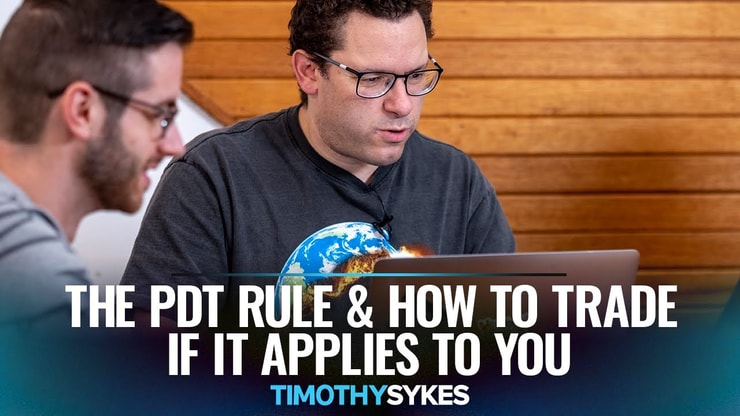Short answer: no, the PDT Rule doesn’t apply in Canada — at least, not if you’re trading through a Canadian broker.
But if you’re a Canadian trader using a U.S. broker to access U.S. markets? That’s a different story.
Understanding the Pattern Day Trader (PDT) rule isn’t just about compliance — it’s about protecting your capital and knowing when the rules change based on where and how you trade. I’ve traded and taught students globally, and this rule trips up more traders than it should. Let’s fix that.
You should read the article to learn what the PDT rule means for Canadian traders, among other cross-border trading regulations.
I’ll answer the following questions:
- Does the PDT Rule apply in Canada?
- What is the Pattern Day Trader (PDT) Rule?
- What are the key requirements and restrictions of the PDT?
- How does the PDT rule impact Canadian traders trading in U.S. markets?
- Are there any Canadian-specific rules similar to the PDT?
- How can Canadian traders best prepare for day trading given the regulatory landscape?
Let’s get to the content!
Table of Contents
- 1 What Is the Pattern Day Trader (PDT) Rule?
- 2 Understanding the PDT Rule
- 3 Status of the PDT Rule in Canada
- 4 Implications for Canadian Day Traders
- 5 Tips for Navigating Day Trading Rules in Canada
- 6 Key Takeaways
- 7 Frequently Asked Questions (FAQs)
- 7.1 How Does the PDT Rule Impact Canadian Traders Trading in U.S. Markets?
- 7.2 Are There Any Canadian-Specific Rules Similar to PDT?
- 7.3 How Can Canadian Traders Best Prepare for Day Trading Given the Regulatory Landscape?
- 7.4 What Are the Key Market Participants in Canadian Trading?
- 7.5 How Do Trading Activities Vary Among Shares and Currencies?
- 7.6 Does Canada Have Specific Agreements Regarding the PDT Rule?
- 7.7 What Should Traders Know About Market Dynamics and Jobs?
- 7.8 How Do You Find Reliable Information on Trading Regulations in Canada?
- 7.9 How Do Canadian Traders Manage Client Relations and Customer Service?
What Is the Pattern Day Trader (PDT) Rule?
The Pattern Day Trader rule (PDT) is a U.S. regulation enforced by FINRA and the SEC. Here’s the PDT’s definition:
- If you place 4 or more day trades in a rolling 5-day period using a margin account, you’re classified as a Pattern Day Trader — and your account must maintain a minimum balance of $25,000 USD.
Fall below that amount and try to day trade again? Your broker can freeze your account or limit you to closing positions only.
This rule only applies to U.S.-based brokers and accounts — but if you’re a Canadian trading through a U.S. platform, it can absolutely apply to you.
Understanding the PDT Rule
To put it simply: if you’re trading frequently on margin in a U.S. account and don’t have $25K, you’re going to run into problems.
The rule doesn’t care about your trading strategy — whether it’s scalping, momentum, or technical setups. It’s purely based on activity: 4+ round-trip trades in 5 business days = PDT flag.
That triggers the $25K equity requirement, which has to be met before the market opens. If you don’t meet it, expect trade restrictions or account lockdowns.
The PDT rule doesn’t apply to cash accounts — but then you’re limited by settlement times, which can slow down your trading pace.
Origin and Purpose of the PDT Rule
The PDT rule was introduced in the U.S. after the dot-com bubble burst to reduce risk among undercapitalized traders. Regulators saw too many small accounts getting wiped out from overtrading on margin.
The goal: make sure active traders have more skin in the game. By requiring $25K in a margin account, the SEC and FINRA aimed to filter out inexperienced traders and reduce volatility.
Whether or not it works is up for debate — but if you’re using a U.S. broker, it’s the law of the land.
Key Requirements and Restrictions of PDT
Here’s what triggers the PDT rule:
-
You place 4 or more day trades in 5 business days
-
You do this in a margin account
-
Your account is below $25,000 USD
Once you’re flagged, you’ll either need to deposit funds to meet the requirement — or your broker may restrict your account to closing-only trades.
Some brokers enforce PDT more aggressively than others. Know your broker’s policy before you place your trades.
Status of the PDT Rule in Canada
If you’re using a Canadian broker, like Questrade, Wealthsimple, or Interactive Brokers Canada, the PDT rule does not apply.
Canada has no direct equivalent to the PDT rule. Canadian brokers don’t limit your trades based on frequency — though margin accounts still come with their own requirements under IIROC regulations.
That said, Canadian traders using U.S. platforms — or trading through U.S. brokerages — are still subject to the PDT rule. That’s where most of the confusion happens.
More Breaking News
- ARM Faces Market Challenges: What’s Next?
- Baytex Energy: Stock Turbulence Amid Lower Price Targets
- Ericsson Stock Rises: What’s Fueling the Surge?
Does the PDT Rule Apply in Canada?
No, the PDT rule isn’t enforced by Canadian regulators. But if you’re trading through a U.S. broker (like using TD Ameritrade or a U.S. Interactive Brokers account), yes — it applies to you.
If you’re not sure whether your broker is U.S. or Canadian based, you need to find out. The broker’s regulatory body — not your nationality — determines whether PDT rules apply.
If you’re a Canadian using a U.S. broker with a U.S. margin account, you’re under PDT rules.
Canada doesn’t impose PDT-style restrictions — but that doesn’t mean it’s unregulated.
-
IIROC (Investment Industry Regulatory Organization of Canada) regulates brokers and margin accounts
-
Brokers may still impose minimum account balances or require additional capital for high-frequency trading
-
Tax implications are serious: trade too often, and the CRA may classify your gains as business income, not capital gains
So while you’re free from PDT rules, you’re not free from oversight.
Differences Between Canadian and U.S. Day Trading Regulations
The main difference between Canadian and U.S. day trading regulations lies in the specific restrictions on trading frequency and required account minimums. Canada does not impose the same stringent rules as the PDT, allowing more flexibility for traders. However, Canadian regulations still emphasize the importance of risk management and responsible trading practices.
Here’s a point-by-point breakdown:
| Day Trading Regulations | U.S. | Canada |
|---|---|---|
| PDT applies to margin accounts | ✅ Yes | ❌ No |
| $25K minimum for active day trading | ✅ Yes | ❌ No |
| 4+ day trades in 5 days triggers restrictions | ✅ Yes | ❌ No |
| Local enforcement | FINRA / SEC | IIROC / CSA |
| Taxed as business income | ✅ Yes | ✅ Yes (CRA discretion) |
Implications for Canadian Day Traders
If you’re trading U.S. stocks through a U.S. broker — even if you’re based in Canada — you’re under PDT rules. That means:
- You need $25K USD in your margin account to day trade freely
- If you hit the 4-trade threshold, you risk account restrictions
- You must monitor how your broker classifies your activity
The big mistake? Thinking you’re safe because of your passport. It’s your broker’s jurisdiction that matters.
Trading Platforms and Brokers in Canada
If you want to avoid the PDT rule altogether, stick with Canadian platforms.
Popular choices:
-
Questrade — flexible, low commissions
-
Wealthsimple Trade — no commissions, limited features
-
Interactive Brokers Canada — robust platform, global access
Canadian platforms can offer access to U.S. markets. Make sure you’re trading under Canadian account terms, not U.S. rules.
While selecting the right trading platform or broker, it’s also worth considering the strategy you intend to employ. Swing trading, for instance, is a popular method in Canada due to its strategic balance between speed and analysis. It requires a platform that can keep up with the swift yet calculated moves of the trader. For a deep dive into what you need to know about swing trading in Canada, including the platforms that best support this trading style, this informative article provides valuable insights.
Day Trading in Tax-Free Savings Accounts (TFSA)
Yes, you can buy and sell stocks in a TFSA — but day trading is risky here.
If the CRA sees your activity as business-like, they can retroactively remove your TFSA’s tax-free status and hit you with taxes and penalties.
Reporting Day Trading Income in Canada
If you’re actively day trading, the CRA may classify your income as business income, which is 100% taxable at your marginal rate.
This is different from capital gains, where only 50% is taxed.
If you’re making frequent trades — especially on margin — assume the CRA will treat your profits as business income and plan your taxes accordingly.
Navigating the day trading rules in Canada means staying informed and prepared. It’s about knowing your trading account inside and out — what triggers a margin call, how your ETFs and bonds are treated under Canadian investment law, and the implications of each deposit and withdrawal.
- Use Canadian brokers if you want to avoid PDT
- Know whether you’re using a margin or cash account
- Avoid day trading in TFSAs and RRSPs
- Learn the tax implications of your strategy
- Be cautious with U.S.-based brokers unless you’re ready for PDT compliance
Best Practices for Canadian Day Traders
- Start small — don’t go all-in without a strategy
- Use a simulator before risking real capital (paper trading is underrated)
- Focus on risk management first, profits second
- Track your trades and build a journal
- Don’t confuse activity with progress — overtrading is a fast way to lose money
Adopting best practices as a Canadian day trader also means utilizing the best tools available to simulate and plan your trades. Paper trading platforms in Canada offer a risk-free environment to develop and test strategies. They are an essential component of a trader’s toolkit, especially for those just starting out. To explore the top paper trading platforms available in Canada and find the one that suits your trading style, check out this list.
Avoiding Common Pitfalls and Misconceptions
Make sure you’re not thinking any of the following…
-
“I’m Canadian, so PDT doesn’t apply.”
→ It might, if you’re using a U.S. broker. -
“I can day trade in my TFSA.”
→ You can, but you’ll lose your tax-free status if the CRA decides it’s business income. -
“I’ll just use margin without understanding the risks.”
→ That’s a great way to blow up your account. Learn first, trade second.
Understanding the nuances of penny stocks is crucial to avoid the common pitfalls in trading. Canadian penny stocks, while offering high potential returns, come with their own set of risks and considerations. To navigate this complex market, a comprehensive guide can be invaluable. For those looking to deepen their understanding of penny stocks in Canada, this comprehensive guide is a must-read, offering detailed insights into the Canadian penny stock market.
Key Takeaways
- The PDT rule doesn’t apply to Canadian brokers, but it does apply if you use a U.S. broker
- It can apply to Canadian brokers transacting in U.S. markets
- Always confirm your broker’s regulatory jurisdiction
Trading isn’t rocket science. It’s a skill you build and work on like any other. Trading has changed my life, and I think this way of life should be open to more people…
I’ve built my Trading Challenge to pass on the things I had to learn for myself. It’s the kind of community that I wish I had when I was starting out.
We don’t accept everyone. If you’re up for the challenge — I want to hear from you.
Apply to the Trading Challenge here.
Trading is a battlefield. The more knowledge you have, the better prepared you’ll be.
Are you under the PDT? Let me know in the comments — I love hearing from my readers!
Frequently Asked Questions (FAQs)
How Does the PDT Rule Impact Canadian Traders Trading in U.S. Markets?
Canadian traders trading in U.S. markets must adhere to the PDT rule, which can affect the number of trades they can execute and the capital required in their accounts.
Are There Any Canadian-Specific Rules Similar to PDT?
While Canada does not have a rule identical to the PDT, IIROC imposes its own regulations that focus on protecting investors and the integrity of the markets.
How Can Canadian Traders Best Prepare for Day Trading Given the Regulatory Landscape?
Canadian traders should educate themselves on both Canadian and U.S. regulations, maintain a disciplined trading strategy, and ensure they have adequate funds to meet any cross-border regulatory requirements.
What Are the Key Market Participants in Canadian Trading?
In Canadian trading, key market participants include individual customers, corporate clients, and workers employed across various companies and industries. These entities often interact to provide a wide range of financial products and services.
Trading activities in Canada involve a diverse set of financial instruments, from shares to currencies. Companies offer products and services tailored to these activities, which can include a large lot of trades in some cases.
Does Canada Have Specific Agreements Regarding the PDT Rule?
In Canada, the PDT (Pattern Day Trader) rule, as enforced in the United States, does not directly apply. However, there are country-specific regulations that govern similar trading agreements and negotiations.
What Should Traders Know About Market Dynamics and Jobs?
Understanding market dynamics is crucial, especially for those seeking jobs in the trading industry. Times of volatility may increase the number of cases where quick decision-making is essential for job roles tied to trading activities.
How Do You Find Reliable Information on Trading Regulations in Canada?
For those seeking an answer on whether the PDT rule applies in Canada, reliable information can often be found by taking the time to research regulatory articles or by contacting the office of financial regulatory bodies. It’s important to consider every aspect of the thing in question, and not to assume that something that applies in one country, like the rules under the Trump administration, applies elsewhere.
How Do Canadian Traders Manage Client Relations and Customer Service?
Canadian traders often emphasize personal interaction with clients and customers, ensuring they provide tailored services and products. A person seeking advice on trading will find that companies invest time in understanding client needs, often going beyond the office to offer something more substantial in terms of support and information.











Leave a reply